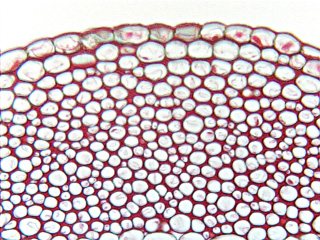 Fig. 4.1-1.
Transverse section of stem of angelica (Angelica). This mass of
collenchyma has several very common features:
Fig. 4.1-1.
Transverse section of stem of angelica (Angelica). This mass of
collenchyma has several very common features:
1.
It is close to the epidermis (actually touching the epidermis here).
2.
There are many layers of collenchyma cells, not just two or three.
3. The corners of the cells are so thickened
that the cell lumens (the white areas) are more of less circular even though the
cells themselves are actually angular.